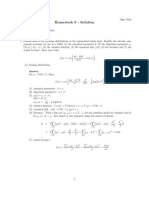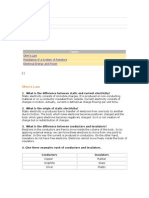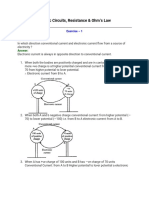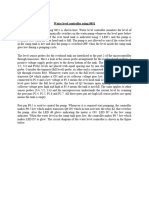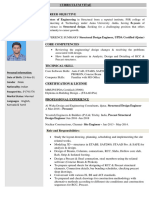0 ratings0% found this document useful (0 votes)
18 viewsTech 1 To 100
Tech 1 To 100
Uploaded by
Jevan CalaqueCopyright:
© All Rights Reserved
Available Formats
Download as PDF, TXT or read online from Scribd
Tech 1 To 100
Tech 1 To 100
Uploaded by
Jevan Calaque0 ratings0% found this document useful (0 votes)
18 views4 pagesOriginal Title
TECH 1 TO 100
Copyright
© © All Rights Reserved
Available Formats
PDF, TXT or read online from Scribd
Share this document
Did you find this document useful?
Is this content inappropriate?
Copyright:
© All Rights Reserved
Available Formats
Download as PDF, TXT or read online from Scribd
Download as pdf or txt
0 ratings0% found this document useful (0 votes)
18 views4 pagesTech 1 To 100
Tech 1 To 100
Uploaded by
Jevan CalaqueCopyright:
© All Rights Reserved
Available Formats
Download as PDF, TXT or read online from Scribd
Download as pdf or txt
You are on page 1of 4
1. The rate of movement of charge through any conductor is known as current.
2. The tending to move the electricity is called e.m.f.
3. The ratio of voltage and current in a closed circuit remains constant.
4. The unit measuring resistance is ohm.
5. With the increases in length of conductor, the value of resistance increases.
6. With the increase in cross-sectional area of the conductor, the value of resistance decreases.
7. Specific resistances of a conductor depend upon composition of the conductor.
8. With the increase of temperature, the resistance of carbon decreases.
9. When a high resistance is connected in parallel with a low resistance the combined resistance is
less than the lower resistance.
10. Which of the following insulator is most affected by heat? V.P.C
11. With the increase in temperature, the resistance of copper increases.
12. Which the rise of temperature, the temperature coefficient of resistance? Increases
13. Which of the following material possess the least specific resistance? Silver
14. Which of the following material has a negative temperature coefficient? carbon
15. Which of the following material has the lowest resistivity? copper
16. Which of the following material has nearly zero temperature coefficient of resistance? silver
17. Three resistances of values 8 ohms, 12 ohms and 24 ohms are connected in parallel across 100
volts supply. The value of potential; difference across each resistance will be more than 100
volts.
18. Nichrome wire is commonly used for heating elements.
19. The unit of electrical energy is kilo-watt-hour.
20. Power taken by a resistance of 20 ohms with a flow of 10 amp current is 2 kW.
21. A current of 5 amp flow through a conductor against a potential deference of 200 volts. The
power dissipated will be 1000 watts.
22. A 100 volt is applied to a circuit of resistance of 10 ohms, the power dissipated by the resistance
will be 1000 watts.
23. Energy consumed by a heater of rating 1000 watts by operating it for a period of 2 hours will 2
kW-hr.
24. Three resistances of 1 ohm, 2 ohms, and 3 ohms respectively are connected in series across a
battery of 6 volts, the total resistance of the circuit will be 6 ohms.
25. Three resistance of 6 ohms each are connected in parallel across 6 volts supply, the total
resistance of the circuit will be 2 ohms.
26. A wire of resistance R its length and cross-section both doubled. Its resistance will become R.
27. Two lamps of rating 60 W, 100 V and 100 W, 100 V are connected in series across 200 volts
supply. The current drawn by both the lamps will be same.
28. Four-heaters of rating 1 kW, 250 V each are available. How you will connect them for maximum
heat all in parallel.
29. The greatest voltage drop in a circuit will occur when the greater the current flow through that
part of the circuit.
30. Two heaters of rating 1 kW, 250 V are connected in series 250 volts supply, the power taken by
the heaters will be ½ kW.
31. Resistance results in loss of electrical energy from the circuit.
32. As the temperature increases, the resistance of most conductors also increases, except carbon.
33. Of the six ways of producing emf. Which method is used the least? Friction
34. Resistance in the power formula equals E2/W.
35. What the formula to find watt hours? E x I x T
36. In a series circuit when the voltage remains constant and the resistance increases, the current
decreases.
37. In series circuit with four unknown resistive load, it is certain that the current flowing through
each load will be the same.
38. Other factors remaining the same, the effect on the current flow in the circuit would cause the
current to double if the applied voltage was doubled.
39. The electrons in the last orbit of an atom are called valence electrons.
40. A toaster will produce less heat on low voltage because its total watt output decreases.
41. A substance whose molecules consist of the same king of atoms is called element.
42. A length of wire has a resistance of 6 ohms. The resistance of a wire of the same material three
times as long and twice the cross-sectional area will be 9 ohms.
43. The hot resistance of a 100 watt incandescent bulb is about 10 times its cold resistance.
44. The purpose of load in an electrical circuit is to utilized electrical energy.
45. The conductance of a conductor is the ease in which current flows through it. It is measured in
mhos.
46. Electrical appliances are connected in parallel because it makes the operation of appliances
independent of each other.
47. The cord on a heating iron would most likely have an insulation of asbestos.
48. Nichrome wire having a resistance of 200 ohms per feet is to be used for a heater that requires a
total resistance of 10 ohms. The length of wire required would be 50 feet.
49. If 18 resistances each 36 ohms are connected in parallel, the total resistance would be 2 ohms.
50. For heater coils with a given voltage will consume the most power when connected all in
parallel.
51. A voltmeter measures voltage difference.
52. If the clips on a cartridge fuse become hot, this is a god indication that the fuse clips are too
loose.
53. The resistance in a circuit may be used to identify a loose connection.
54. Which of the following bets conductor in electricity? Aluminum
55. Ohm`s law states E is equal to I times R.
56. Which of the following would have the least amount of resistance? conductor
57. Specific resistance of a conductor depends upon composition of conductor.
58. The opposite of resistance would be conductance.
59. Resistance can be found directly from wattage and voltage measurements by the equation
R=V2/W.
60. The rate of movement of charge through any conductor is known as current.
61. The force tending to move the electricity is called e.m.f.
62. The ratio of voltage and current in a closed circuit remains constant.
63. The unit of resistance is ohm.
64. For long transmission lines, voltage is measured in kilo-volts.
65. With the increases in length of conductor, the value of resistance increases.
66. With the increase in cross-sectional area of conductor, the value of resistance decreases.
67. With the increase in temperature, the resistance of copper increases.
68. With the increase in temperature, the resistance of carbon decreases.
69. Which of the following insulator is most affected by heat P.V.C
70. With the increase in temperature, insulating property of insulator weakens.
71. The specific resistance of mica is very low.
72. With the rise of temperature, the coefficient of resistance decreases.
73. Which of the following material possesses the least specific resistance silver.
74. Which of the material has a negative temperature co-efficient carbon.
75. A voltage of 100 V is applied to a circuit of resistance of 10 ohms, the power dissipated by the
resistance will be 1000 watts.
76. When a high resistance is connected in parallel with a low resistance, the combined resistance is
less than the lower resistance.
77. Three resistance of values of 8 ohms, 12 ohms and 24 ohms are connected in parallel across 12
V supply, the total resistance of the circuit will be 4 ohms.
78. Which of the following material has nearly zero temperature co-efficient of resistance
managing.
79. The unit of force in M.K.S system is Newton.
80. Which of the following statements is true the longer the conductor, the greater its resistance.
81. Which of the following material has the lowest resistivity copper.
82. The unit of electrical energy is kilo-watt-hour.
83. Horse power is true unit of power.
84. In M.K.S system one horse power is equal to 830 watts.
85. A current of 5 A flows through a conductor against a potential difference of 200 V. the power
dissipated will be 1000 W.
86. Three resistances of 6 ohms each are connected in parallel across 6 V supply. The total
resistances of the circuit will be 12 ohms.
87. Two resistance of 4 ohms and 6 ohms are connected in parallel across 12 V supply, the total
resistance of the circuit will be 2.4 ohms.
88. The resistance of a conductor when its temperature is increased increases.
89. The resistances of a wire double if we double its length.
90. What is the formula of ohm`s law? I=V/R.
91. What do you understand by the term `voltage drop’? The voltage across a resistance.
92. Upon which of the factors does the voltage drop depend? Upon the resistance of the conductor
and the current flowing through it.
93. In a series connection of two resistors the current is, at very point of the circuit the same.
94. In a parallel connection the voltage is the same at all resistances.
95. What are the units of electrical power? Joule, kilo joule (j,Kj)
96. Voltage, applied across a circuit, acts as a force.
97. If on a constant resistance we increase the supply voltage to double its value, then the power
will be four times as high.
98. Two wires with different cross-sectional areas are connected in series. The heat produced by the
current is greater in the thinner wire because there is a higher current through it.
99. Which of the following formulae for calculating the electrical power is correct? P=I2 x R
100. What is called the electro-motive force (e.m.f) of a voltage source? Internal voltage when no
load is applied,
You might also like
- Homework 8 - SolutionDocument8 pagesHomework 8 - SolutionMaricarmen GalvezaNo ratings yet
- 04 Burgers Advice Haccp Plan 0Document6 pages04 Burgers Advice Haccp Plan 0chun leung Lam100% (1)
- Stress Ribbon and Cable Supported Pedestrian Bridges - Prof. Ing. Jiří StráskýDocument40 pagesStress Ribbon and Cable Supported Pedestrian Bridges - Prof. Ing. Jiří Stráskýtyukgomba100% (1)
- Tech 1 To 100Document4 pagesTech 1 To 100Jeric RavalNo ratings yet
- QUESTIONDocument4 pagesQUESTIONAlbert CuartoNo ratings yet
- Class 10 Electricity NumericalsDocument2 pagesClass 10 Electricity NumericalsMayank Kumar Jha90% (10)
- Docsocial Science UmentDocument12 pagesDocsocial Science UmentparthebiswasNo ratings yet
- ElectricityDocument29 pagesElectricitycuteprincess.mistyNo ratings yet
- Electricity_bpzajdbdh43muedi7vxfDocument21 pagesElectricity_bpzajdbdh43muedi7vxfANVI POPHALINo ratings yet
- 10.12.ElectricityWorksheetDocument4 pages10.12.ElectricityWorksheetafraz.arshiNo ratings yet
- Is Electric Current A Scalar or Vector QuantityDocument3 pagesIs Electric Current A Scalar or Vector QuantityAshok PradhanNo ratings yet
- EE 603 - DC CircuitsDocument19 pagesEE 603 - DC CircuitsCtstrphyNo ratings yet
- Current ElectricityDocument70 pagesCurrent ElectricitycodeNo ratings yet
- 10 Phys assignment Chapter 10_241202_191010Document2 pages10 Phys assignment Chapter 10_241202_191010monmutmk20No ratings yet
- Science Class 10Document11 pagesScience Class 10Shayashree and varshini RNo ratings yet
- Is Electric Current A Scalar or Vector QuantityDocument3 pagesIs Electric Current A Scalar or Vector QuantityAshok Pradhan100% (1)
- NCERT Solutions For Class 10 Science Chapter 12 ElectricityDocument29 pagesNCERT Solutions For Class 10 Science Chapter 12 ElectricityManwinder Singh GillNo ratings yet
- Basic Ee Hw1Document2 pagesBasic Ee Hw1mon patrick pradoNo ratings yet
- Tech 101 To 200Document4 pagesTech 101 To 200Jevan CalaqueNo ratings yet
- WS Electricity-1Document5 pagesWS Electricity-1fatimasksk1No ratings yet
- CBSE Class 10 Physics Electricity (1) - RemovedDocument29 pagesCBSE Class 10 Physics Electricity (1) - RemovedAtul BiloniyaNo ratings yet
- ElectricityDocument9 pagesElectricitymohametabdirahman334No ratings yet
- Super Elex 4Document10 pagesSuper Elex 4Charles Adrian CNo ratings yet
- Important Viva QuestionsDocument19 pagesImportant Viva QuestionsAtul Tripathi100% (1)
- MC Electrical CircuitsDocument8 pagesMC Electrical CircuitsMelvin Garcia QuirosNo ratings yet
- Ac311 MDocument6 pagesAc311 MjerkNo ratings yet
- Ee 312Document6 pagesEe 312anon_936382570No ratings yet
- Chapter 1: Basic Atomic Theory: Key PointsDocument4 pagesChapter 1: Basic Atomic Theory: Key PointsDaahirshiiq MadoobeNo ratings yet
- Electricity QuestionsDocument6 pagesElectricity QuestionsMicky2306No ratings yet
- Class 10 Science Chapter 11 Practice Question Answers - ElectricityDocument14 pagesClass 10 Science Chapter 11 Practice Question Answers - ElectricitysanjurajeshbhatNo ratings yet
- Electricity class X NCERT Solutions-Document11 pagesElectricity class X NCERT Solutions-topperblankNo ratings yet
- Que - Bank BEEDocument2 pagesQue - Bank BEEmangeshdeepaliNo ratings yet
- Electricity Class X NotesDocument15 pagesElectricity Class X NotesGrgg Hkhkk100% (5)
- 3.CURRENT ELECTRICITY WorksheetDocument4 pages3.CURRENT ELECTRICITY WorksheetAdithyaNo ratings yet
- Supplementary Problems Electrical CircuitsDocument2 pagesSupplementary Problems Electrical Circuitsmae50% (2)
- Elex QuexDocument75 pagesElex QuexJHOEMEL TANGO100% (1)
- MathDocument76 pagesMathJHOEMEL TANGONo ratings yet
- Imp Ques X ans keyDocument7 pagesImp Ques X ans keyvibhors848No ratings yet
- Ohm's Law and Electric CircuitsDocument46 pagesOhm's Law and Electric CircuitsGabriel Carl Alpuerto100% (1)
- Class 10 Science ELECTRICITYDocument12 pagesClass 10 Science ELECTRICITYDebsuvro RoyNo ratings yet
- Ohm's Law and Circuits: 2. Conductance, Insulators and ResistanceDocument29 pagesOhm's Law and Circuits: 2. Conductance, Insulators and ResistanceDita PramidaNo ratings yet
- Review Exam ELEC Questions and AnswersDocument27 pagesReview Exam ELEC Questions and AnswersheelchristianNo ratings yet
- Electricity DPP QuestionsDocument4 pagesElectricity DPP Questionsjam.gamesrNo ratings yet
- Electricity WorksheetDocument11 pagesElectricity Worksheetsrijankanduri14No ratings yet
- Resistance and Conductance: E.M.F Can Be Defined AsDocument5 pagesResistance and Conductance: E.M.F Can Be Defined AsBubacarr ChamNo ratings yet
- 36160chapter 2 Current and ResistanceDocument17 pages36160chapter 2 Current and Resistancemrb96mptqqNo ratings yet
- Electricity Class 10 NotesDocument10 pagesElectricity Class 10 NotesKota SrinadhNo ratings yet
- My 4 Static ElectricityDocument22 pagesMy 4 Static ElectricityAfzal HossainNo ratings yet
- OriginalDocument5 pagesOriginalomarNo ratings yet
- Electricity One Shot Class10Document49 pagesElectricity One Shot Class10saracastic123No ratings yet
- Problem Set Ee-121Document15 pagesProblem Set Ee-121Eme Dumlao17% (6)
- Viva Physics Doc 1 - Mother DivineDocument20 pagesViva Physics Doc 1 - Mother DivineAaryan ChhabraNo ratings yet
- Electricity WorksheetDocument2 pagesElectricity WorksheetNot AlinaNo ratings yet
- Worksheet-Electricity: Class-XDocument1 pageWorksheet-Electricity: Class-Xveeresh punjaniNo ratings yet
- Powerpoints Electric CircuitsDocument9 pagesPowerpoints Electric CircuitsmvmbappleNo ratings yet
- Electric Circuits, Resistance & Ohm's Law: AnswerDocument60 pagesElectric Circuits, Resistance & Ohm's Law: Answerdhanukrishnag0% (1)
- WK 7 - Q3 - GP2 - GSJDocument59 pagesWK 7 - Q3 - GP2 - GSJildeanne GNo ratings yet
- Final ws-1 Phy 10th ClassDocument5 pagesFinal ws-1 Phy 10th Classcharithsharma7No ratings yet
- PHY 102 Lecture HandoutDocument22 pagesPHY 102 Lecture Handoutdivome2006No ratings yet
- Chapter 26. Current and ResistanceDocument28 pagesChapter 26. Current and ResistanceOsama HassanNo ratings yet
- Complete Electronics Self-Teaching Guide with ProjectsFrom EverandComplete Electronics Self-Teaching Guide with ProjectsRating: 3 out of 5 stars3/5 (2)
- Motion Picture Operation, Stage Electrics and Illusions: A Practical Hand-book and Guide for Theater Electricians, Motion Picture Operators and Managers of Theaters and ProductionsFrom EverandMotion Picture Operation, Stage Electrics and Illusions: A Practical Hand-book and Guide for Theater Electricians, Motion Picture Operators and Managers of Theaters and ProductionsNo ratings yet
- Preboard 2 - RME APRIL 2023Document5 pagesPreboard 2 - RME APRIL 2023Jevan Calaque0% (1)
- SasasDocument1 pageSasasJevan CalaqueNo ratings yet
- Solicar Engineering Review Center and ServicesDocument7 pagesSolicar Engineering Review Center and ServicesJevan CalaqueNo ratings yet
- Rme April 2019 Exam 7 Key PDFDocument8 pagesRme April 2019 Exam 7 Key PDFJevan CalaqueNo ratings yet
- 9-Engineering Data AnalysisDocument4 pages9-Engineering Data AnalysisJevan CalaqueNo ratings yet
- Rme Quick View Part 8Document11 pagesRme Quick View Part 8Jevan Calaque0% (1)
- Practice Exam No. 4 2018 PDFDocument43 pagesPractice Exam No. 4 2018 PDFJevan CalaqueNo ratings yet
- Practice Exam No. 2 2018 PDFDocument23 pagesPractice Exam No. 2 2018 PDFJevan CalaqueNo ratings yet
- Practice Exam No. 3 2018 PDFDocument29 pagesPractice Exam No. 3 2018 PDFJevan CalaqueNo ratings yet
- Rme April 2019 Exam 3 Key PDFDocument7 pagesRme April 2019 Exam 3 Key PDFJevan CalaqueNo ratings yet
- Rme April 2019 Exam 5 Key PDFDocument8 pagesRme April 2019 Exam 5 Key PDFJevan CalaqueNo ratings yet
- Rme April 2019 Exam 1 Key PDFDocument7 pagesRme April 2019 Exam 1 Key PDFJevan CalaqueNo ratings yet
- Rme April 2019 Exam 2 Key PDFDocument7 pagesRme April 2019 Exam 2 Key PDFJevan CalaqueNo ratings yet
- Pec Answers 301 To 400Document7 pagesPec Answers 301 To 400Jevan CalaqueNo ratings yet
- 7solid Geometry OC PDFDocument5 pages7solid Geometry OC PDFJevan CalaqueNo ratings yet
- 8analytic Geometry 2 OC PDFDocument4 pages8analytic Geometry 2 OC PDFJevan CalaqueNo ratings yet
- Rme April 2019 Exam 4 Key PDFDocument8 pagesRme April 2019 Exam 4 Key PDFJevan CalaqueNo ratings yet
- Day 10 - Ra7920-Pec-Epira-PdcDocument10 pagesDay 10 - Ra7920-Pec-Epira-PdcJevan CalaqueNo ratings yet
- Edx Org Course Engineering Calculus and Differential EquationsDocument1 pageEdx Org Course Engineering Calculus and Differential EquationsJevan CalaqueNo ratings yet
- Probability PDFDocument7 pagesProbability PDFJevan CalaqueNo ratings yet
- Pec Answers 601 To 700Document5 pagesPec Answers 601 To 700Jevan CalaqueNo ratings yet
- Thermodynamics: Multiple Choice Questions inDocument19 pagesThermodynamics: Multiple Choice Questions inJevan CalaqueNo ratings yet
- Three Times Only The Subjects in Which He Has Obtained The Grade Below 50%Document5 pagesThree Times Only The Subjects in Which He Has Obtained The Grade Below 50%Jevan CalaqueNo ratings yet
- Tech 501 To 600Document3 pagesTech 501 To 600Jevan CalaqueNo ratings yet
- Tech 201 To 300Document4 pagesTech 201 To 300Jevan CalaqueNo ratings yet
- Tech 101 To 200Document4 pagesTech 101 To 200Jevan CalaqueNo ratings yet
- Tech 401 To 500Document4 pagesTech 401 To 500Jevan CalaqueNo ratings yet
- Tech 301 To 400Document4 pagesTech 301 To 400Jevan CalaqueNo ratings yet
- Licensure Examination For TeachersDocument2 pagesLicensure Examination For TeachersJevan CalaqueNo ratings yet
- Dry Run Test-2Document1 pageDry Run Test-2Jevan CalaqueNo ratings yet
- StandardDocument24 pagesStandardIonut2010No ratings yet
- Seal Gas BoosterDocument2 pagesSeal Gas BoosterMatthieuNo ratings yet
- Nasal Mucoadhesive Drug Delivery: Background, Applications, Trends and Future PerspectivesDocument26 pagesNasal Mucoadhesive Drug Delivery: Background, Applications, Trends and Future PerspectivesEduardMartinezNo ratings yet
- Asme Guide For Sec Viii Div 1Document1 pageAsme Guide For Sec Viii Div 1siddharth pawarNo ratings yet
- Marketing & Distribution Strategy of HCL Info SystemDocument78 pagesMarketing & Distribution Strategy of HCL Info SystemUmesh TyagiNo ratings yet
- Temporary Structure: Raymond G. Blanco DOLE OSH PractitionerDocument42 pagesTemporary Structure: Raymond G. Blanco DOLE OSH PractitionerAviects Avie JaroNo ratings yet
- فسلجة دم الطيورDocument604 pagesفسلجة دم الطيورMustafa AL-Asadsy100% (1)
- Options For A WInd Loading CodeDocument10 pagesOptions For A WInd Loading CodeTuroyNo ratings yet
- EE 4208 Digital Signal Processing LabDocument4 pagesEE 4208 Digital Signal Processing LabTenda TiyNo ratings yet
- Gorton's Keeps Moving: Lean Successes in The Plant, The Supply Chain, and The OfficeDocument6 pagesGorton's Keeps Moving: Lean Successes in The Plant, The Supply Chain, and The OfficeMichael CullinanNo ratings yet
- H2 Chem Data BookletDocument11 pagesH2 Chem Data Bookletchkln2011No ratings yet
- Botany Multiple Choice QuestionsDocument7 pagesBotany Multiple Choice QuestionsAsnad KoppathNo ratings yet
- Sample of BoQ Fo Transitional and Repair of SheltersDocument5 pagesSample of BoQ Fo Transitional and Repair of SheltersMujibullah sarwaryNo ratings yet
- Water Level Controller and Traffic Light Controler Using 8051Document5 pagesWater Level Controller and Traffic Light Controler Using 8051arunambrose2004No ratings yet
- MC3 Microbiology and Parasitology (19, 20, 21)Document9 pagesMC3 Microbiology and Parasitology (19, 20, 21)Kaye Tan LuagueNo ratings yet
- Copa b737-800 MaxaffDocument11 pagesCopa b737-800 Maxaffedgaraucapina787No ratings yet
- Rasa Rat Nasa Muc ChayaDocument8 pagesRasa Rat Nasa Muc ChayaVenkatesh PNo ratings yet
- How To Windows 7,8,10Document51 pagesHow To Windows 7,8,10Muhammad ParasNo ratings yet
- Sashi Booshan CVDocument3 pagesSashi Booshan CVsashibooshanNo ratings yet
- Full Length Test Part 2Document4 pagesFull Length Test Part 2Priyanka DubeyNo ratings yet
- Line Up April 07Document8 pagesLine Up April 07Gary Edrein LajaNo ratings yet
- Selectarc ElektrodyDocument149 pagesSelectarc ElektrodymalyczopekNo ratings yet
- Oisd STD 244-Draft - III 1Document119 pagesOisd STD 244-Draft - III 1akhilendraa6221No ratings yet
- Behnia 2013Document17 pagesBehnia 2013tazwar zahidNo ratings yet
- Article Tanjung Pelepas Port From Jungle To Malaysia Newest Container Port 80 01Document10 pagesArticle Tanjung Pelepas Port From Jungle To Malaysia Newest Container Port 80 01Tong TonggNo ratings yet
- GTI Field Operations Manual v2 - 2Document85 pagesGTI Field Operations Manual v2 - 2abbeyNo ratings yet
- Mediaeval Swords From Southeastern Europe 12th To 15th CenturyDocument205 pagesMediaeval Swords From Southeastern Europe 12th To 15th CenturygoguhistoryNo ratings yet
